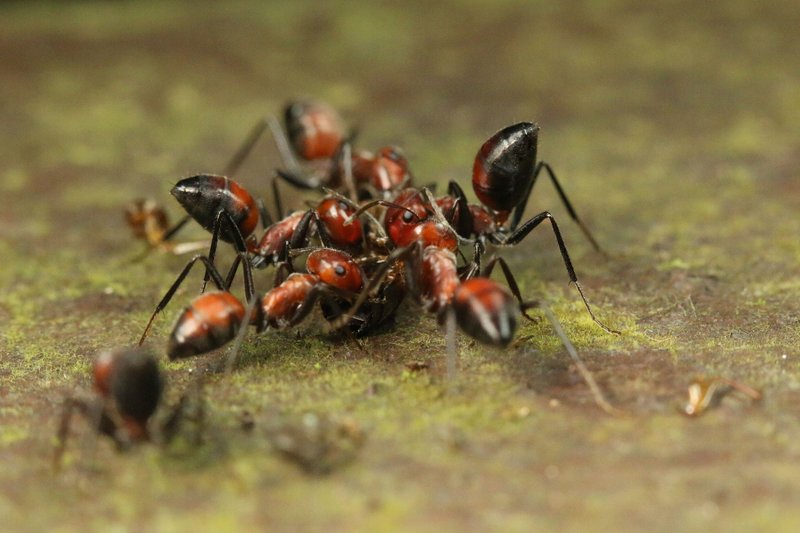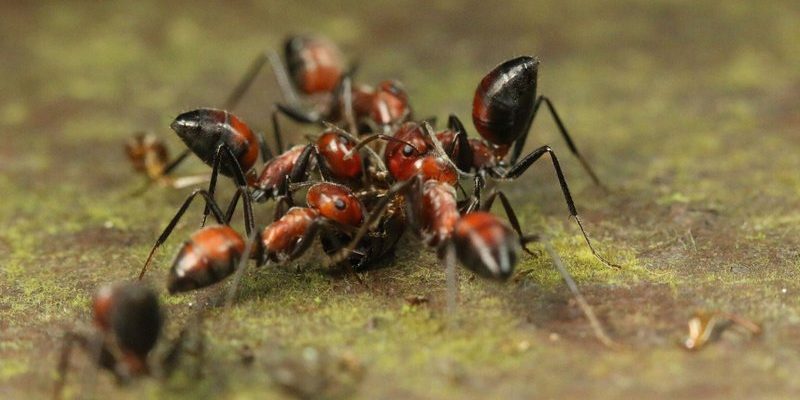
Imagine carpenter ants as tiny architects, busy constructing their wooden homes while constantly on guard against various threats. From larger animals to environmental factors, these hardworking ants have to remain vigilant. You might be wondering who poses a threat to these industrious builders. Let’s dive into the dangers lurking in the shadows and what it means for carpenter ants.
Natural Predators of Carpenter Ants
Carpenter ants have their fair share of natural enemies in the wild. Just like in any community, they’re part of the food chain. Here are some of their main predators:
- Birds: Many birds, such as woodpeckers and certain species of sparrows, have a taste for ants. Woodpeckers, in particular, are skilled at pecking into wood to find carpenter ants nesting inside.
- Ant-Eating Mammals: Animals like anteaters or even some species of bears may feast on carpenter ants when the opportunity arises. They use their long snouts and sharp claws to dig into the nests.
- Other Insects: Some predatory insects, such as certain wasps and spiders, are also known to hunt carpenter ants. These predators are sometimes overlooked but can be significant threats.
Each of these predators has its unique strategy for catching these ants. For instance, woodpeckers can hear the rustling of ants inside the wood, making them natural hunters. It’s a tough world out there for carpenter ants, where staying hidden is key to survival.
Parasites and Diseases: Hidden Hazards
In addition to physical predators, carpenter ants face threats from various parasites and diseases. Just like humans, these ants can fall victim to tiny invaders that can compromise their health.
- Microsporidia: These are microscopic parasites that can infect carpenter ants and weaken their immune systems. An infected ant may not be able to forage effectively, making it more vulnerable.
- Fungal Infections: Certain fungi can infiltrate ant colonies, spreading quickly and leading to the demise of many ants within a single nest. These infections can decimate populations before they even realize they’re under attack.
- Nematodes: These microscopic worms can invade carpenter ants, leading to their death. They latch onto ants and use them as a host to reproduce, which spells trouble for the ant colony.
Understanding these hidden hazards is critical for appreciating how fragile ant colonies can be. Their ability to thrive despite these challenges is nothing short of impressive.
Environmental Threats to Carpenter Ants
The environment itself poses significant threats to carpenter ants. Changes in climate and habitat can drastically affect their survival.
One major factor is habitat destruction. When forests are cleared for agriculture or urban development, carpenter ants lose their homes. Not only do they lose their nesting sites, but they also face increased competition for resources as they become more concentrated in smaller areas.
Moreover, changes in weather patterns can cause fluctuations in their food supply. For instance, prolonged drought can affect the availability of tree sap and other food sources that ants rely on. When food is scarce, their colonies may struggle to survive.
Lastly, increased pesticide use can pose a significant threat. While these chemicals are used to control pests, they can also unintentionally harm non-target species, like carpenter ants. If enough ants are affected, it could lead to a decline in their populations.
Competition with Other Ant Species
Just as carpenter ants have their predators, they also contend with competition from other ant species. In nature, it’s a struggle for resources, and sometimes, other ants can be just as dangerous as any predator.
- Fire Ants: These aggressive ants can invade the territory of carpenter ants and compete for food. Their painful sting makes them formidable opponents.
- Argentine Ants: Known for forming super colonies, Argentine ants can outcompete carpenter ants for food and nesting sites, often leading to the decline of local carpenter ant populations.
- Pharaoh Ants: These tiny ants often invade homes, competing for the same food resources as carpenter ants. Their ability to thrive indoors can threaten carpenter ant colonies that venture too close to human habitation.
This competition can be fierce, and sometimes, carpenter ants might have to flee or adapt to survive. It’s a constant battle for territory and resources, showcasing the struggle of life in the ant world.
Human Impact on Carpenter Ant Populations
Humans have a significant influence on carpenter ants, often without realizing it. While we may see them as pests, our activities can directly impact their populations.
One of the biggest impacts is landscaping and home maintenance. When homeowners treat their properties with insecticides, they might inadvertently wipe out carpenter ant colonies. This can create a ripple effect in the local ecosystem since ants play a crucial role in decomposition and soil health.
Another example is global trade, which can introduce non-native species into new environments. These introduced species can sometimes outcompete local ants, affecting their populations.
Lastly, climate change, driven by human activity, can alter the habitats that carpenter ants depend on. As temperatures rise and weather patterns shift, these ants may find it increasingly difficult to thrive in their traditional environments.
Conservation of Carpenter Ants and Their Habitat
Despite their challenges, there’s hope for carpenter ants. Conservation efforts can help protect their habitats and populations. Here are a few ways to support these fascinating insects:
- Preserving Forests: Supporting sustainable forestry practices can help maintain the natural habitats where carpenter ants thrive. When habitats are preserved, ants have a better chance of survival.
- Reducing Pesticide Use: By opting for natural pest control methods, we can protect not just carpenter ants but the entire ecosystem.
- Promoting Biodiversity: Encouraging a diverse range of plant life in your garden can create a welcoming environment for carpenter ants and other beneficial insects.
By understanding the threats carpenter ants face and taking action, we can help them continue their role as nature’s hard workers. It’s a team effort between humans and nature to ensure that these remarkable ants can survive and thrive.
In conclusion, carpenter ants are more than just wood-nibbling pests. They face numerous predators and threats, from birds and mammals to diseases and human influences. By understanding these challenges, we can appreciate their resilience and take steps to protect them. Whether it’s through careful gardening or supporting conservation efforts, every little bit helps these incredible creatures continue their essential roles in our ecosystems.

